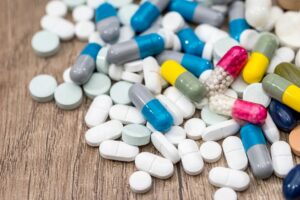Most people have heard the phrase “opioid crisis” in the news recently, but do non-healthcare workers really understand what all the fuss is about? This blog will explain the risks and benefits of opioid use and help readers learn why there is so much national attention surrounding this issue.

What are opioids? Opioids are a class of drugs that act in the brain to help manage severe pain. Some are naturally occurring derived from the opium poppy plant. These include morphine, codeine, and heroin. There are also synthetic opioids such as fentanyl, oxycodone, and hydrocodone. While these drugs when prescribed appropriately are considered to be among the most effective pain reducers available, they can also be highly addictive. They also pose additional risks including both physical and mental dependence, withdrawal symptoms, and overdose.
Explaining the ‘crisis’: Opioid addiction affects approximately 2.4 million people in the U.S., with nearly 1 million of these individuals abusing heroin as their drug of choice. In October 2017, the government declared a public health emergency regarding this issue. According to the Center for Disease Control and Prevention (CDC), 140 Americans die from drug overdoses daily. 91 of those deaths can be directly attributed to opioid use, either prescription medications, heroin, or illegally manufactured fentanyl.
How did this happen? In the late 1990s, pharmaceutical companies reassured the medical community that patients would not become addicted to prescription opioid pain relievers if they really needed the medications, and healthcare providers began to prescribe them at greater rates. This then led to widespread misuse and diversion of these medications before it became clear that they were indeed highly addictive. Overdose rates began to increase leading to the current crisis state.
What do we know?
- Roughly 21-29% of patients prescribed opioids for chronic pain misuse them (take more than needed or for longer than needed)
- Between 8-12% develop on opioid use disorder (intense desire to use opioids)
- Estimated 4-6% of those who misuse their prescription opioids eventually transition to heroin, mostly because it is easier to get than the prescription drugs
- About 80% of heroin users first misused a prescription opioid
- The Midwest saw opioid overdoses increase by 70% from July 2016 through September 2017
Why do people abuse opioids? One of the side effects from opioids that leads to its abuse is the sense of euphoria or feelings of sedation and relaxation. The user wants to repeat these sensations, so they keep taking the drugs and need more and more to get the same effects as the body becomes dependent. This is called tolerance and leads to withdrawal symptoms if there is abrupt discontinuation of the drug. Addiction occurs when the dependence negatively interferes with daily life. It eventually takes over the person’s ability to make good choices and the drug cravings are all the user can think about.
Signs and symptoms of opioid abuse: Poor coordination, slurred speech, tiny pupils, drowsiness, slowed breathing, nausea, constipation, moodiness, poor decision making, lack of responsibility, excessive sleeping, euphoria, lack of motivation
What can be done? Safe and efficient options to assist with opioid addiction are available, but prevention is key! Knowing the safest way to take these medications when needed is the most important step in protecting yourself from the risks.
Risk Factors for Opioid Abuse:
- If you have a personal or family history of addiction
- You take medicines to treat mental health conditions

How to take opioid pain medications safely:
- Tell your healthcare providers about ALL the medications you are taking, including vitamins, herbal supplements and other over-the-counter medications
- Take your opioid medication EXACTLY as prescribed
- Read the medication guide that comes with your medication and ask your pharmacist any questions you might have
- Do not cut, break, chew, crush or dissolve your opioid medication unless told to do so by your provider
- Questions to ask your provider:
- How long should I take it?
- What should I do when I am ready to taper off the opioid medication?
- What do I do if this medication is not controlling my pain? [do NOT increase the dose on your own]
- Do NOT share or give your opioid medication to anyone else. This is not safe, nor legal.
- Store opioid medication in a safe place where it cannot be reached by children or stolen by family members or visitors to your home (diversion). Keep track of the amount of medication you have.
- Do not operate heavy machinery or drive a vehicle until you know how the medication will affect you. These medications can make you sleepy, dizzy, or lightheaded.
What should I avoid while taking opioids?
Unless prescribed by your provider, you should avoid alcohol or taking any of the following medications with an opioid. Combining may cause you to stop breathing, which can lead to death.
- Alcohol: do NOT drink alcohol at all while you are taking opioid medications
- Benzodiazepines (such as Valium, Xanax, Ativan)
- Muscle relaxants
- Sleeping medications
- Other prescription opioid medications
**When you no longer need your opioid medication and have safely tapered off, dispose of it as quickly as possible. DO NOT save it for another time or give it to anyone else. The FDA recommends that most opioids be promptly flushed down the toilet when no longer needed. A list can be found here: www.fda.gov/drugdisposal
For more information about opioid medications, visit: www.fda.gov/opioids
Blog Written By: Angie Erickson, PharmD, RPh, Hospital Pharmacist

